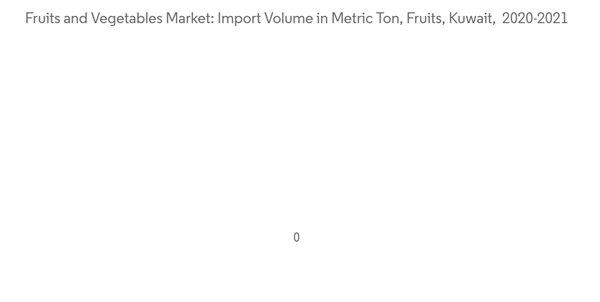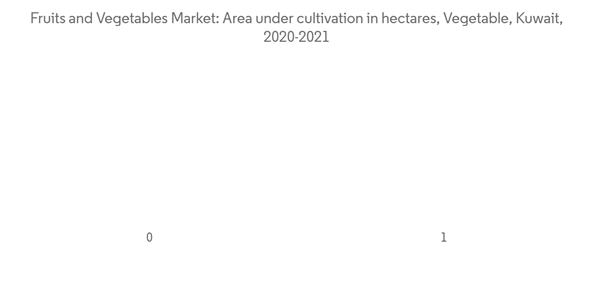Key Highlights
- The country has low domestic production capabilities for fruits and vegetables, as the soil in the region is soft in organic content, has low-nutrient holding abilities, and has poor moisture-retaining capacity. The natural water resources required for irrigation are minimal, with most of the water used from desalination plants, which consume a lot of electricity, increasing the cost of farming for domestic farmers, as there are no subsidies for electricity in the country.
- The Government of Kuwait is encouraging agricultural companies to invest in foreign countries with a comparative advantage in producing certain crops and importing their products back into Kuwait. The Kuwaiti government provides financial incentives to encourage investors to participate in this food security initiative and invest overseas. Thus, the harsh climatic conditions and vulnerable water and soil resources are the significant constraints faced by the agriculture sector in Kuwait; hence, the country primarily depends on importing fruits and vegetables.
- Furthermore, the non-issuance of non-exposure permits for some sales centers and owners of stalls, no parallel operation of supermarkets in the commercial areas, precautionary policies forced upon some cooperatives and markets, discontinuation of the 'barcode' system for individual shopping and stopping restaurants and groceries from buying vegetables and fruits are some of the significant factors influencing the fruits and vegetables market in the country. Thus, the growing demand for fruits and vegetables in Kuwait is attributed to the increasing disposable incomes of the people and the increasing health concerns of the Kuwaiti population.
Kuwait Vegetables and Fruits Market Trends
Import of Fruits and Vegetables to meet the Domestic Demand
The country has a total arable land area of about 10,600 ha, or about 0.6% of the total land area. This domestic production capacity is insufficient to cater to the growing demand for fruits and vegetables. Kuwait is the second-most populated country in the GCC region, with an average population growth rate of 3.5%. The government has low domestic production capabilities for fruits and vegetables, as the soil in the region is soft in organic content with low nutrient-holding abilities and poor moisture-retaining capacity. The natural water resources required for irrigation are minimal, with most water used coming from desalination plants that consume a lot of electricity. Domestic farmers cannot bear the costs as there are no subsidies for electricity.Thus, the agricultural sector in Kuwait faces significant challenges due to harsh climatic conditions and vulnerable water and soil resources. Hence, the country mainly depends on importing fruits and vegetables. The United States, Lebanon, India, and South Africa are the major exporters of fruits to the country. As per the ITC trade map, in 2021, the country's overall import volume of fruits accounted for 49,227 metric tons, with the United States and Lebanon holding a significant share of 29.1% and 17.3%. Further, India, Jordan, Lebanon, and Egypt are the major exporters of vegetables to the country. Hence, the increased demand for fruits and vegetables in the country with the less favorable cultivation conditions created a market potential for imports, which is further anticipated to drive the market in the country during the forecast period.
Increased Area and Innovation in Agriculture
The agricultural areas in the country are located in Wafra, in the south of Kuwait, Al-Abdali, in the north of Kuwait, and Al-Sulaibiya, in the center. According to the Food and Agriculture Organization, the total area under cultivation of fruits and vegetables in the country has increased significantly in recent years. Tomatoes, cucumbers, dates, eggplants, pumpkins, lettuce, watermelons, strawberries, and oranges are some of the major crops produced in the country. The overall area harvested under the vegetables of primary importance in 2021 accounted for 5,164 hectares, which increased from 4,951 hectares in 2019.Due to environmental and water resource problems, the country relies a lot on supplemental irrigation and greenhouse production. In 2020, the first large-scale indoor vertical farm in the Middle East opened in Kuwait. It used Dryponics technology to grow 250 kinds of greens and herbs. With approximately 3,000 square meters of farming space, the innovative facility has a daily output capacity of up to 550 kg of salad, herbs, and cresses and uses cutting-edge vertical farming methods that consume 90% less water than traditional farming. Also, the government recognizes the need to bring in dryland urban agriculture, innovative technologies, and skilled labor to enhance its food production. Thus, the increased area and innovation in agriculture are anticipated to drive the market during the coming year.
Additional Benefits:
- The market estimate (ME) sheet in Excel format
- 3 months of analyst support
This product will be delivered within 2 business days.










